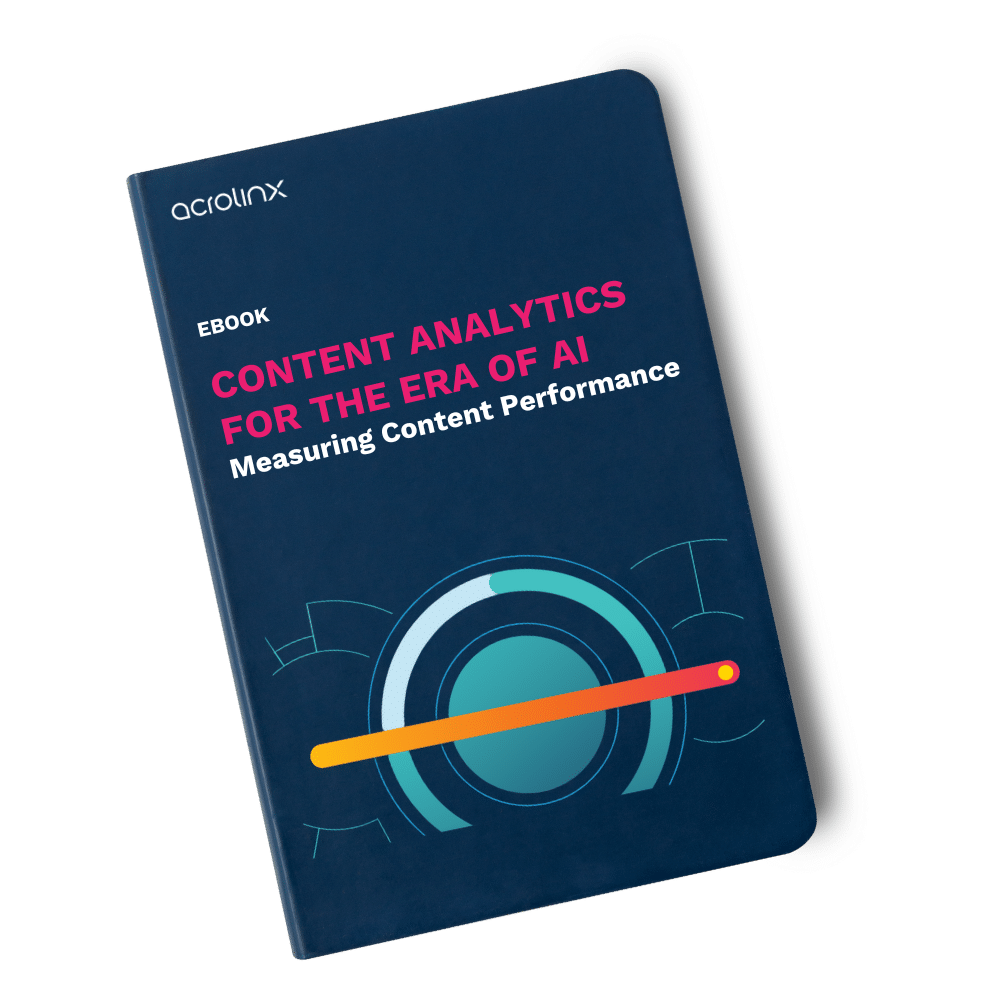
Content performance metrics are vital for determining the success, impact, and quality of your enterprise content. The problem is that most organizations don’t know where to start. And they often assume they should only be measuring content marketing efforts.
In this blog, we detail the four types of content performance metrics that matter, and highlight the most important ones your enterprise needs to focus on. That’s because not all metrics are created equal — as some provide more informative insights than others.
It’s also worth remembering that Google Analytics isn’t the only place where content analytics can be found. Yes, it centralizes data points like bounce rate, click through rate (CTR), and conversion rate, but it doesn’t take into account the changes in your SEO ranking (like Ahrefs or BuzzSumo) or your number of MQLs for the quarter. Needless to say, there are a lot of ways to calculate the success of your content.
Let’s dig in!
How to measure content production effectively
Content production metrics are the most basic type of metric you should be tracking. And while they’re the simplest, and therefore yield the fewest insights, they’re still important. Not only do they help keep you accountable, they can also cast a light on inefficiencies in your content creation process.
With content production metrics, you’re simply keeping tabs on whether or not you’re actually delivering all the content you’ve committed to creating as part of your goals. If you’ve said you’re going to publish two blog posts a week, a biweekly podcast, a monthly content marketing asset, and a customer case study, are you actually producing all of that?
Keeping track of this stuff is an important reality check. If your content team isn’t meeting its commitments, it could mean you’re trying to do too much with too few resources. Or maybe it’s a sign you’re not allocating your resources efficiently.
Beyond keeping track of whether or not you’ve created everything you’ve committed to, you should also keep an eye on each of the following data points:
- Was your content completed on time?
- How long did it take to create from start to finish? (Here, make sure you’re looking at both the total hours worked and how much time elapsed while that work was getting done.)
- How much did it cost to create? (This should include any expenses you incurred using third-parties or subscription services, and the relative costs of you and your colleagues’ time.)
This data will help you better understand the efficiency of your content creation efforts. Eventually, as you become a well-oiled machine, you might find that each type of content you’re creating generally takes a certain amount of time to produce and costs a certain amount of money.
Once you have insight into this, it’s best to keep tracking these details, since they can be leading indicators of any problems that may surface downstream. With the data handy, you’ll be able to identify trend shifts early and correct them sooner. Another good goal is to see if you can become more efficient and reduce the amount of time, money, and effort required to create your content by fine-tuning your processes.
Content performance metrics
Anytime you publish a piece of content, the usual knee-jerk reaction is to look for immediate validation about its performance. How many people saw it, liked it, and shared it on social media? And while such information can be motivating, the reality is that it’s not entirely useful.
When it comes to helping you deliver better business outcomes, only a handful actually matter. Think of content performance metrics as falling into two buckets: vanity and performance. Let’s look at each one in detail.
Vanity metrics: Tracking brand recognition
An increase in these metrics is a clear indication that you’re reaching more people and helping to grow your brand. But, there’s no way to know for sure that they actually help drive meaningful business results. That’s why they’re called vanity metrics. They’re more useful for making content marketers feel good about themselves than they are for demonstrating actual impact.
The most common ones are:
- Views / listens: The number of times that someone has looked at, watched, or listened to one of your content pieces.
- Sessions: A count of the number of distinct interactions users have with your website. A single session might include multiple activities, such as visiting different pages, sharing content, or buying a product.
- Session duration: The average number of time visitors spend on your site.
- Time on page: A measure of how much time people spend on any given individual page on your site.
- Social shares and likes: A count of the number of times that visitors share your content through their personal social media channels or like your content.
- Open rates: The percentage of people who open the emails you send them.
- CTR: The percentage of people who click on a link you send them that’s contained within an email or other communication. This includes calls to actions (CTAs).
- Users: The total number of people who have visited your website during a given period of time. To avoid double-counting repeat visitors, look for the number of unique users.
But the question remains: is there a problem with vanity metrics?
It’s important to take them with a grain of salt.
The reality is that they’re not always true indicators of meaningful engagement with your content. After all, although we like to think that every view and listen equates to a prospect taking the time to consume our content in full, that’s simply not the case. You’ve only got to land on a page or hit the play button for a second for it to be counted. In cases like that, at best the person wound up there by accident and was never actually your intended target. At worst, the person was your target and got turned off because they didn’t like what they found.
So, while vanity metrics can certainly make you feel good, remember, when it comes to driving actual business outcomes, they aren’t particularly meaningful. Use them directionally to gauge the relative popularity of your content. But don’t tie them to the success or failure of your content efforts, or use them to try to impress your C-Suite.
Content performance metrics: Generating business growth
If you want content performance metrics that will command your C-Suite’s attention and earn their respect, you have to track how you’re helping your company meet its business objectives. Fundamentally, the main way that content does this is by helping to generate qualified leads. In many businesses, this is the primary metric that matters.
But there are intermediary steps that a prospect can take that are also worth reporting on. These include:
- Goal completions
- The length of your sales cycle
- Customer service costs
Content performance metrics are important, but you have to know which ones have real implications for your business and which ones don’t. While you want to improve all of these content analytics, keep in mind that the only one that ultimately matters to your executive team is how you helped drive sales by delivering qualified leads.
How to measure return on investment (ROI) in content marketing
Everything that we’ve looked at so far is useful, but ROI metrics take things a step further. They demonstrate the value you’re creating for your business by investing time and money in content. Unfortunately, calculating the ROI of your content is a lot easier said than done. In fact, according to research from HubSpot, 21 percent of marketers say that proving the ROI of their marketing activities is their top marketing challenge. But it’s an activity that’s worth doing. Marketers who do calculate it report that they’re 1.6 times more likely to receive higher budgets.
When it comes to ROI metrics, two things matter:
- How much value your content is generating overall
- How much it’s generating on a piece-by-piece or type-by-type basis
That way, you can measure your ROI in general as well as for specific assets and types of assets.
If you want a formula for how to create an ROI calculator for content and content marketing metrics, download our guide: The Definitive Guide to Content Analytics.
Measuring impact of content & importance of governance
The major flaw that all of the metrics we’ve looked at so far share is that they’re only available to you once you’ve published your content. And while you can still use them to make changes to your content, you’re left to understand what kind of changes are needed.
It’s easy to understand how content is performing. The challenge lies in understanding what qualities the content needs to resonate with your audience, and how to guide your writers to make these changes. To get the best results, you also need metrics that can help you improve your content and your content creation processes for new and existing content. That’s where impact and governance metrics come in. Let’s take a closer look at each.
Using content analytics to assess impact before publishing
With content governance software like Acrolinx, you can scan, score, and fix your content before you publish it, measuring it against a number of key quality metrics proven to impact performance.
Acrolinx offers quality checks before publishing by integrating directly into your content creation workflows. It automatically analyzes your content to ensure it meets the standards set in your style guides, including clarity, tone, consistency, terminology, and compliance with regulations. If any issues are detected, Acrolinx provides clickable suggestions that allow writers to fix errors easily. This process helps ensure that only high-quality content moves forward to publication. Additionally, quality gates can be set up to block content that doesn’t meet required standards, preventing it from being published until it meets your expectations.
There’s no doubt that great content creates strong engagement that leads to qualified conversions. Yet many organizations overlook the connection between the quality of content and its performance. Marketers have long gauged the success of their content through data points like page views, bounce rate, and conversion rate. But until now, they’ve lacked the ability to correlate how improved content can positively impact those engagement metrics, and ultimately lead to higher conversions.
Why content governance matters for consistency and performance
To access content analytics like these, companies need to practice content governance. Content governance is a systematic approach to capturing and digitizing your company’s content strategy; measuring your current content status; actively guiding content creation to achieve your established goals; and improving performance over time. In other words, it takes the key elements of your content strategy — your goals, priorities, and policies — and turns them into actionable processes and analytics.
Content governance matters as it promotes consistency and quality across all produced content, maintaining a reliable brand voice that fosters trust among audiences. It helps organizations comply with industry regulations, reducing the risk of legal issues or penalties. By streamlining content creation processes, governance enables the efficient production of high-quality content at scale, which is vital in fast-paced environments. Additionally, it minimizes risks associated with inaccuracies or biases in both AI-generated and human-written content, protecting reputation and credibility.
Companies that practice content governance, using a platform like Acrolinx, can capture critical data about their content marketing programs, which they can then use to improve performance. For example, it helps to:
- Identify underperforming content and direct the resources necessary to fix it before publishing
- Fuel better customer experiences by easily identifying, ranking, and fixing stale and underperforming content
- Avoid random spot checks and instead measure every piece of content to achieve 100 percent quality
- Provide self-service writing guidance that makes content creation faster and less costly
- Streamline global content update practices for mergers, rebrands, product releases, and other terminology updates
- Insert automated quality checks anywhere in the content lifecycle to prevent editorial bottlenecks, keep content to an exceptionally high standard, and remain free of compliance risks
Grow your business through content analysis
Make no mistake. To create successful content, you need to be able to measure what you’re doing and the impact it’s having on your business. But that doesn’t mean you have to get bogged down in the data or become a victim of analysis paralysis.
In this blog, we’ve outlined the top metrics that power businesses toward content success. Now it’s up to you to decide which ones you’ll track, at what frequency, and how. Focus on the ones you think will be most meaningful for your company.
And remember, simply tracking Google Analytics isn’t a useful exercise. To derive value from them, you need to analyze them for insights and use those insights to inform decisions about how to optimize what you’re doing. Once you pull that off, everything else will start to fall into place. Download our guide to learn more or let’s talk to see how Acrolinx can help your enterprise.
Frequently asked questions
Via engagement, readability, and conversion metrics. Acrolinx uniquely ties content quality to business outcomes through analytics.
By evaluating clarity, tone, and performance metrics. Acrolinx scores content and allows you to correlate it with real outcomes.
Use dashboards and reports to track alignment with goals. Acrolinx enables this through quality scoring and integration with BI tools.
Are you ready to create more content faster?
Schedule a demo to see how content governance and AI guardrails will drastically improve content quality, compliance, and efficiency.

Charlotte Baxter-Read
Lead Marketing Manager at Acrolinx, bringing over three years of experience in content creation, strategic communications, and public relations. She holds a Master’s degree from the John F. Kennedy Institute, at Freie Universität Berlin, and a Bachelor's degree from Royal Holloway, University of London. Charlotte, along with the Acrolinx Marketing Team, won a Silver Stevie Award at the 18th Annual International Business Awards® for Marketing Department of the Year. She's a passionate reader, communicator, and avid traveler in her free time.





